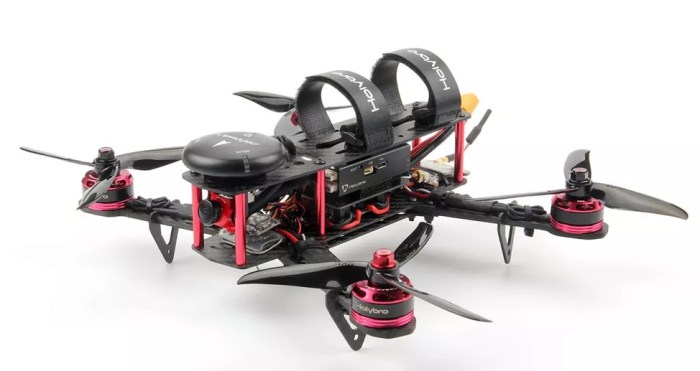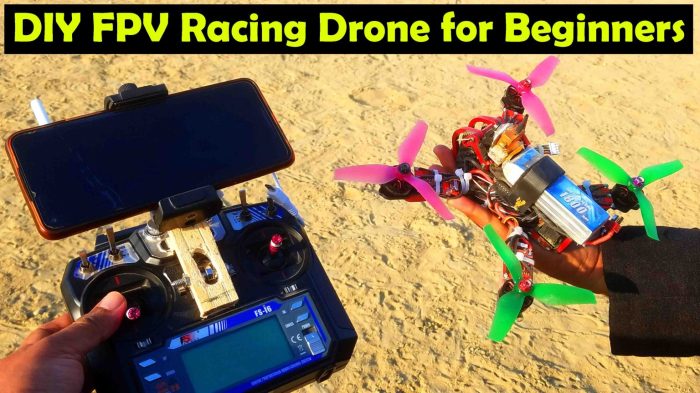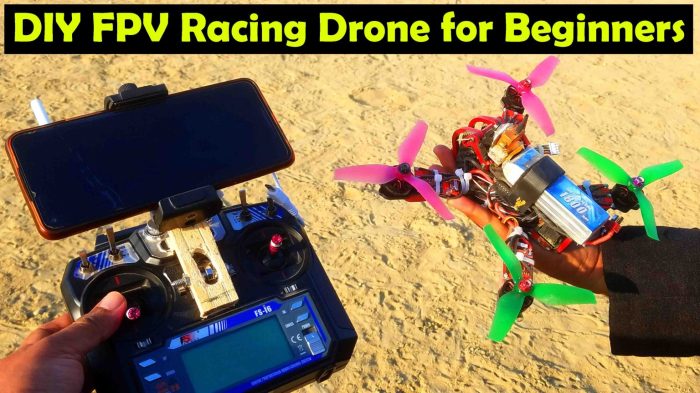DIY FPV drone: the phrase itself evokes a sense of excitement and possibility. It’s about taking control, crafting your own aerial machine, and experiencing the world from a unique perspective. Building your own FPV drone isn’t just about assembling parts; it’s about diving deep into the intricacies of flight, electronics, and software, and ultimately, about pushing the boundaries of what’s possible.
Table of Contents
This journey begins with understanding the core components that make up an FPV drone – the frame, motors, ESCs, flight controller, battery, and receiver. Choosing the right components is crucial, as it directly impacts performance, flight characteristics, and even your budget. This guide will equip you with the knowledge to select components that align with your desired capabilities and style of flying.
Introduction to DIY FPV Drones

A DIY FPV drone is a great way to experience the thrill of flight and explore the world from a new perspective. Building your own drone allows you to customize it to your specific needs and preferences, and it can be a rewarding and educational experience.
Defining FPV Drones and their Components
FPV (First-Person View) drones are unmanned aerial vehicles (UAVs) that are controlled remotely using a video feed transmitted back to the pilot in real-time. This allows the pilot to see what the drone sees, creating an immersive and exciting flying experience.
Here are the main components of a typical FPV drone:
- Frame: The frame provides the structural support for the drone and houses all the other components.
- Motors: These are responsible for propelling the drone through the air. They are typically brushless motors, which offer higher efficiency and longer lifespan than brushed motors.
- Electronic Speed Controllers (ESCs): ESCs control the speed and direction of the motors. They receive signals from the flight controller and convert them into electrical signals to drive the motors.
- Flight Controller: The brain of the drone, responsible for controlling the drone’s flight path and stability. It receives input from sensors like the gyroscope, accelerometer, and barometer, and outputs signals to the ESCs and other components.
- Battery: Provides the power to run the drone. Lithium Polymer (LiPo) batteries are commonly used due to their high energy density and lightweight nature.
- Video Transmitter (VTX): Transmits a live video feed from the drone’s camera to the ground station. The VTX typically operates in the 5.8GHz frequency band.
- Camera: Captures the video feed that is transmitted back to the pilot. FPV drones typically use small, lightweight cameras with wide-angle lenses.
- Video Receiver (VRX): Receives the video signal from the VTX and displays it on a monitor or goggles.
- Ground Station: The ground station is the control center for the drone. It typically includes a transmitter, receiver, monitor, and battery.
Benefits of Building a DIY FPV Drone
Building your own FPV drone offers several advantages over buying a pre-built drone:
- Customization: You can choose the components that best suit your needs and budget, allowing you to create a drone that is tailored to your specific flying style and preferences.
- Learning Experience: Building a drone requires a good understanding of electronics and mechanics. This can be a rewarding and educational experience, allowing you to learn about different components and how they work together.
- Cost Savings: Building your own drone can be more cost-effective than buying a pre-built drone, especially if you are willing to invest some time and effort.
- Troubleshooting Skills: When you build your own drone, you gain valuable experience in troubleshooting and repairing issues that may arise. This can be a valuable skill for anyone interested in electronics and robotics.
Popular DIY FPV Drone Projects
There are numerous resources available online and in hobby stores to help you get started with building your own FPV drone. Popular DIY FPV drone projects include:
- Tiny Whoop: Tiny Whoop drones are small, agile drones that are perfect for indoor flying. They are relatively inexpensive to build and are a great starting point for beginners.
- 3-Inch Drone: 3-inch drones offer a good balance of performance and maneuverability. They are popular for freestyle flying and racing.
- 5-Inch Drone: 5-inch drones are larger and more powerful than 3-inch drones, making them suitable for long-range flying and aerial photography.
Setting Up the Flight Controller

The flight controller is the brain of your FPV drone, responsible for controlling all the motors, receiving input from the receiver, and processing data from the sensors. It’s a crucial component that needs to be set up correctly for your drone to fly smoothly and predictably.
Flight Controller Software Options
Different flight controller software options are available, each with its own set of features and benefits.
- Betaflight is a popular open-source software that offers a wide range of features, including PID tuning, advanced flight modes, and support for various peripherals. It’s known for its flexibility and customization options.
- INav is another open-source software that is commonly used for multicopters. It’s known for its stability and performance, especially for racing drones.
- Cleanflight is a more basic and user-friendly software that’s ideal for beginners. It offers essential features like PID tuning and basic flight modes.
Configuring the Flight Controller, Diy fpv drone
Configuring the flight controller involves setting up various parameters and options to match your drone’s specifications and your desired flight characteristics.
- Connect the Flight Controller to Your Computer: This can be done using a USB cable. Once connected, you can access the flight controller’s settings using the software.
- Configure the Motor Assignments: This involves assigning each motor to its corresponding output on the flight controller. Incorrect motor assignments can lead to uncontrollable behavior.
- Set Up the Receiver: This involves configuring the flight controller to recognize the signals from your receiver, which translates the control inputs from your transmitter to the drone.
- Calibrate the ESCs: This ensures that the motors are properly synchronized and respond correctly to the flight controller’s commands.
- Configure the Sensors: This includes calibrating the accelerometer, gyroscope, and magnetometer to ensure accurate readings and stability during flight.
- Tune the PID Values: PID tuning is a critical process that involves adjusting the proportional, integral, and derivative gains to achieve desired flight characteristics. This involves fine-tuning the responsiveness and stability of the drone.
Calibrating the Sensors
Calibrating the sensors is essential for accurate readings and stable flight. This involves placing the drone in a level position and allowing the flight controller to calibrate the sensors.
Note: The specific calibration steps may vary depending on the flight controller software you’re using. Consult the software’s documentation for detailed instructions.
Customization and Upgrades: Diy Fpv Drone

Once you have a basic DIY FPV drone up and running, the fun really begins! This is where you can start to customize and upgrade your drone to suit your specific needs and preferences. You can make your drone faster, more agile, and more capable of handling different types of terrain.
The world of FPV drone customization is vast and exciting, offering endless possibilities for enhancing performance and personalization. From upgrading core components like motors and batteries to refining flight characteristics with custom firmware, you can tailor your drone to excel in specific flying styles or tackle demanding environments.
Choosing the Right Upgrades
Upgrading your DIY FPV drone is a rewarding experience that allows you to personalize your flying experience. A well-chosen upgrade can dramatically improve your drone’s performance, making it faster, more agile, and more capable of handling different types of terrain.
There are many different types of upgrades available for FPV drones. Here are some of the most common:
- Motors: Higher-performance motors will give your drone more power and speed. Look for motors with higher KV ratings, which indicate the speed at which the motor spins. Higher KV motors are typically more powerful but also draw more current, so make sure your battery and ESC can handle the increased load.
- Propellers: Larger propellers will provide more thrust and lift, while smaller propellers will be more efficient and quieter. Experiment with different sizes and pitches to find the best combination for your drone.
- Battery: A larger or higher-capacity battery will give you more flight time. Look for batteries with a higher C rating, which indicates the maximum discharge rate. Higher C ratings allow the battery to deliver more power to the motors.
- FPV Camera: A better FPV camera will give you a clearer and more detailed view of the world from your drone’s perspective. Look for cameras with higher resolution, wider field of view, and better low-light performance.
- Flight Controller: A more advanced flight controller will give you more control over your drone’s flight characteristics. Some flight controllers offer features such as GPS, OSD, and even autonomous flight modes.
- ESC: An ESC (Electronic Speed Controller) is responsible for controlling the speed of the motors. A higher-quality ESC will provide smoother and more efficient motor control.
- Frame: A stronger or more durable frame will protect your drone from crashes. There are many different types of frames available, from lightweight carbon fiber frames to more robust aluminum frames.
The world of DIY FPV drones is constantly evolving, with new technologies and advancements emerging regularly. By building your own drone, you’re not just a pilot, but a creator, a tinkerer, and an explorer. You’re part of a vibrant community of enthusiasts who share their passion for pushing the limits of aerial flight. So, embrace the challenge, explore the possibilities, and let your imagination take flight with your very own DIY FPV drone.
Building a DIY FPV drone is a rewarding experience, allowing you to customize your aerial adventures. But just like tinkering with electronics, crafting your own lotions can be a fun and satisfying project. If you’re interested in making your own skincare products, check out this great resource on DIY lotions. Once you’ve perfected your lotion recipe, you can enjoy the smooth feeling on your skin while you soar through the skies with your custom-built FPV drone!


